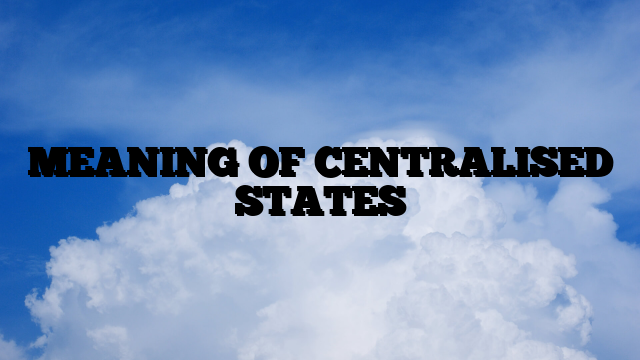Back to: History JSS 1
Welcome to class!
Hello, my amazing JSS 1 student! Welcome back to history class. Today, we’re going to explore a type of political organization that has shaped societies for centuries: centralized states. Get ready to learn about how power is organized and how it affects people’s lives.
Meaning of Centralized States

Imagine your school. If the principal makes all the decisions, and the teachers and students have very little say, that’s a bit like a centralized system. A centralized state is a state where power is concentrated in the hands of a central authority, like a king, a president, or a government. Think of it as a single, powerful center making decisions for the entire state.
In a centralized state, the central government has a lot of control over various aspects of society, including the economy, the military, and the legal system.2 It makes laws, collects taxes, and manages resources. It’s like the headquarters of a company, making all the important decisions for all its branches.
Centralized states often have a hierarchical structure, meaning there are different levels of government, with the central authority at the top. Power flows from the top down. Think of it like a pyramid, with the king or president at the very top, followed by other officials, and then the general population at the bottom.
Centralized states can be very efficient. Because decisions are made at the center, they can be made quickly and implemented consistently across the entire state. This can be particularly important in times of crisis or war. It’s like having one person in charge of organizing your school’s sports day, rather than having different groups doing their own thing.
However, centralized states can also have drawbacks.6 Because power is concentrated in the hands of a few, there’s a risk of abuse of power.7 The central authority might become too powerful and ignore the needs of different regions or groups within the state. It’s like the principal making all the decisions for the school without listening to the teachers’ or students’ opinions.
Another potential problem is that centralized states can be less responsive to local needs.8 Because decisions are made at the center, it can take a long time for local concerns to be addressed. It’s like if you have a problem in your class, but you have to wait for the principal to hear about it and make a decision before anything can be done.
Summary
Centralized states have existed throughout history and in many different parts of the world.9 Ancient Egypt, with its pharaohs, was a centralized state. The Roman Empire, with its emperors, was another example. Many modern nation-states, like Nigeria, also have centralized systems of government, although the degree of centralization can vary.
Centralized states are not necessarily good or bad. Their effectiveness depends on how they are governed and how they balance the need for central authority with the needs of local communities. A good centralized state will strive to be both efficient and responsive to the needs of its people.
Evaluation
Now, let’s check your understanding. Can you explain in your own words what a centralized state is and give an example of a potential benefit and a potential drawback? Think about how a centralized system might affect your community.
Fantastic work! You’re doing a great job exploring these important concepts. Remember, understanding different forms of government is crucial for understanding how societies are organized and how power is distributed. I’m excited to continue this exploration with you in our next lesson!
